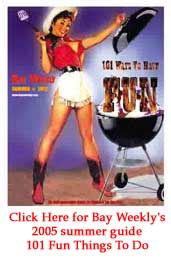 |
Dr. Gouin's Bay Gardener |
Bunnies in the Garden
A little fencing goes far in keeping out these long-jumpers
Rabbits are just as damaging as deer when it comes to gardens. In the vegetable garden, they feast on lettuce, carrot tops, cabbage and broccoli plants, peas and beans. In the landscape they love pansies, verbena, snapdragons and a host of perennials.
The plants that they don’t particularly like are ageratum, cleome, zinnias, marigolds and petunias. Since there are many varieties to choose from each of these species, it is easy to create a colorful flower garden by carefully selecting from these rabbit-resistant varieties.
If rabbits abound in your neighborhood and you wish to grow rabbit-susceptible species, you must either surround the flower beds with 18-inch wide poultry wire or use mothballs. Rabbits do not like the smell of mothballs.
Place four to six mothballs into an empty small frozen juice can and punch a few holes through each metal cover to allow the moth ball odors to escape gradually. The juice can keeps the moth balls dry so they last longer. Scatter the containers through the garden at 10-foot intervals. Mothballs are also good for keeping cats away.
With regard to the vegetable garden, the most effective method for keeping rabbits out is to surround the entire border of the garden with an 18- to 24-inch-tall fence of pullet wire. You need pullet wire because baby bunnies can penetrate regular chicken wire. An 18-inch-tall fence of pullet wire is adequate because rabbits do not jump high, though they can long-jump up to five feet.
Why Roundup Passed My Test
Q Your column of July 7 [Vol. xiii, No. 27] stated that you tested and found Roundup safe. But wasn’t Monsanto, the producer, indicted for providing false data on this product? I understand that its residues linger in the soil for some time, harming worms and microbes, and can get into the water supply.
—Al Peasley, Huntingtown
A It was the surfactants in Roundup that caused problems with water contamination, and that is why Monsanto introduced Rodeo for use near water. In my research, back in the early 1980s, we soaked root balls of several ornamental plants and were never able to measure root uptake except in azaleas. If you read the EPA label, you will note that Roundup is degraded by soil microbes. My research with herbicides started with Agent Orange in the late ’50s; since then, I have conducted research with many herbicides. Of them all, I find Roundup, or glyphosate, to be the safest thus far.
Professor Emeritus Francis Gouin retired from the University of Maryland, where he was the state’s extension specialist in ornamental horticulture. Follow his column of practical gardening and plant advice every week, only in Bay Weekly. Ask Dr. Gouin your questions at [email protected].



